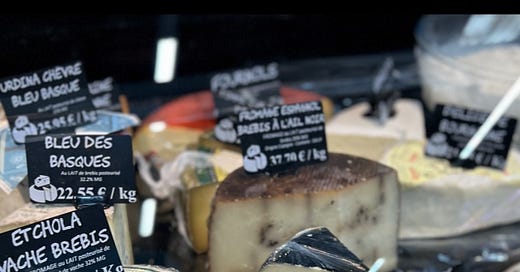I went in for one cheese. Just one.
A nice soft wedge for dinner. Something humble, maybe a Camembert. Something French enough—but not so French it required a small ceremony or a second mortgage.
The Fromageries? Honestly, they’re way over my head right now.
Instead, I found myself frozen in aisle six of the local hypermarché, somewhere between the Roquefort and the Comté, locked in an emotional stand-off with an elderly woman and a stack of Coulommiers so fragrant they could’ve been used to start a perfumery.
She looked at me like I’d never known a real cheese in my life. She was correct.
There were too many cheeses. Too many choices. I wish they had those tables set up like at Costco where I could walk around and try each one with my toothpick.
The labels read like a regional history exam I definitely didn’t study for. And the illustrations? They had little cows or sheep on them—just for me, I guess. Like children’s menus for lost adults. Tomme des Croquants? Saint-Marcellin? Bleu de Gex? Tomme Brebis?
Some were wrapped in straw. One had black dust on it—possibly ash, possibly judgment. One came in a ceramic pot like it had secrets. Do I get to keep the pot? Return it? Does someone refill it like a sacred dairy chalice? Another one was leaking.
I used to think I was a brave person. I left my home all alone. I moved across the world. I rented cars in foreign languages, climbed fences in my underwear, and even held off a French striking mob. And yet here I was, Googling “Is this cheese supposed to smell like moss and sadness?” and praying no one saw me do it.
I tried organizing them in my mind—by region, by milk type, by likelihood of triggering an emotional collapse—but the only thing I knew for sure was that I couldn’t go back to the refrigerated aisle a third time without someone reporting me.
A small child walked confidently past me and whispered something like “Comté 24 mois” with the grace of a sommelier. My first thought was, “That small child can speak French with more confidence than I’ve ever felt in my adult life.” I nodded, pretending I too was on a mission, when in fact I was spiraling next to a wheel of something called Tentation des Moines, which felt personal. It sounded like a scandal and smelled like a dare.
I reached for the cheese with the prettiest label and one with some sort of real flower petals all over it. That’s my vibe, don’t you think? Oh, but what about the one with the cartoon cow and a hand-drawn alpine meadow? Seemed friendly. Manageable. Maybe even forgiving.
I have to keep remembering: Just one, Jenny.
But I’m a Gemini, so naturally I took both. One for aesthetics. One for emotional support.
The Cartoon Cow Cheese? Not friendly…
I got home, opened the package, and was immediately hit by a smell I can only describe as wet wool in a confession booth. My dog sniffed it, looked at me with concern, and left the room. I briefly considered doing the same.
But I didn’t.
Because this was France. And I had something to prove.
Wrap-Up: Emotional Cheese Spiral Landing
So I ate it. All of it. With bread, and shame, and a splash of white wine I found at the back of the fridge.
And I survived.
Because this is what living in France is, sometimes. Not the postcards or the cobblestones or the cinematic sunsets.
But the quiet, crumbling moment where you confront your own reflection in a semi-ripe block of dairy and whisper: “You’ve got this.”
Cheese Interlude (You Knew This Was Coming): A Very Brief Emotional History of French Cheese
To understand why this moment nearly broke me, you must understand that in France, cheese is not just food.
It is legacy. Geography. Identity.
There are over 1,600 distinct cheeses in this country, and at least half of them have legal protection, regional backstories, and feuds that go back to the Middle Ages.
Each one is defined not just by its ingredients, but by where it’s from, what it smells like, how long it’s aged, what the cows ate, how the sheep were conceived, and whether or not someone’s great-grandmother once made it in a stone cellar next to a sacred spring.
There are soft cheeses. Blue cheeses. Crusty cheeses. Washed-rind cheeses that require hazmat protocols. And delicate ones that must be coddled like emotional support animals.
Some are aged in caves. Some are rolled in ash. One might be rubbed lovingly with walnut liqueur and forgotten until it’s sentient.
Cheese isn’t a side dish.
It’s a test.
It’s not a food group.
It’s an initiation ritual.
And today, I failed it.
But tomorrow, I might try again.
Congratulations. You survived the emotional gauntlet of the French cheese aisle.
And as promised, here’s your reward: Fifty Shades of Gruyère:
Bound by rind
Aged to perfection
Smells like commitment issues and ambition
Hard on the outside, melty on the inside
Best paired with wine, regret, and an exit strategy
You thought romance novels were complicated?
Try navigating a dairy aisle at 4 PM on a Sunday in rural France.
Keep reading with a 7-day free trial
Subscribe to A French Table 1 to keep reading this post and get 7 days of free access to the full post archives.



